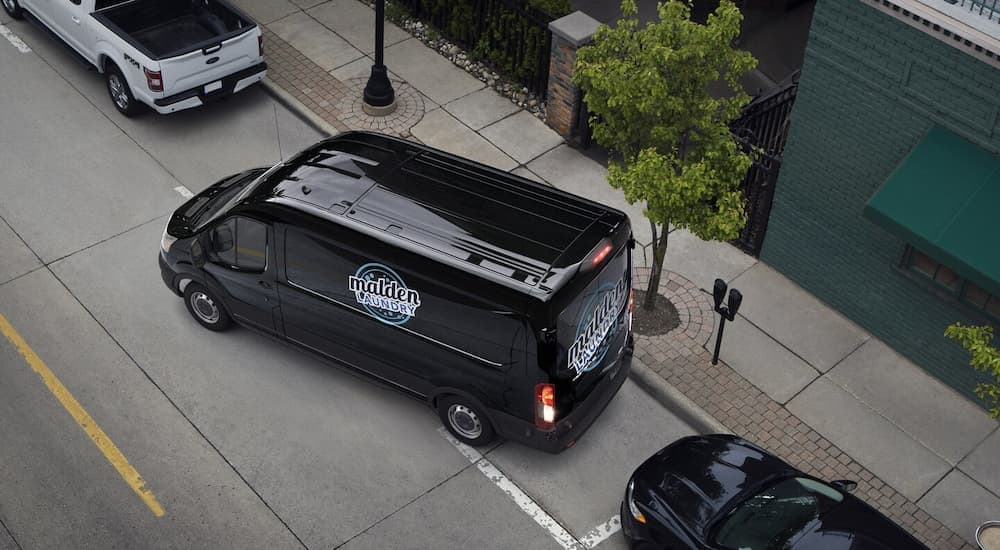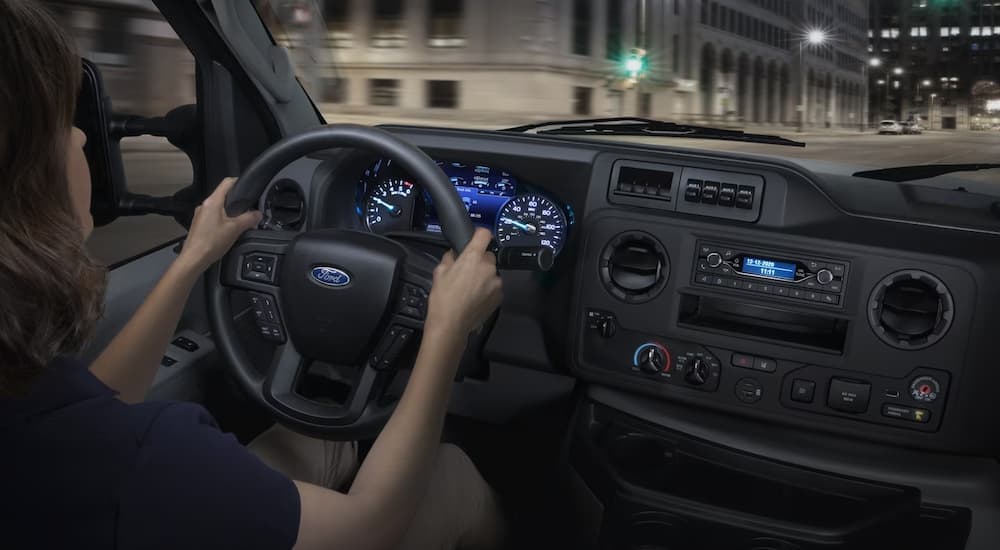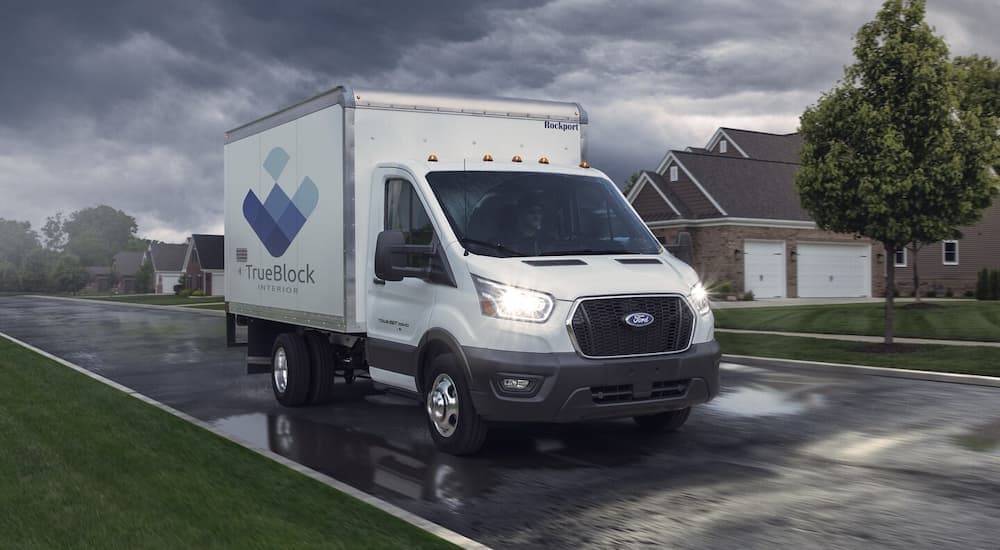
 If you need a van for commercial use, then you’ve probably realized by now that your family-friendly minivan isn’t going to cut it. People who own businesses that rely on vans, from delivery services to dog groomers to movers, need massive vans with cavernous cargo or passenger areas. You need enough space behind the driver’s area to transport all of the goods or people you take from one place to another every day. You don’t want to make unnecessary stops or go back and forth because space is limited. Many drivers come to us asking about a Ford Transit for sale. The massive Ford Transit cargo van has a cavernous rear area that’s ready for outfitting with built-in shelves or toolboxes.
If you need a van for commercial use, then you’ve probably realized by now that your family-friendly minivan isn’t going to cut it. People who own businesses that rely on vans, from delivery services to dog groomers to movers, need massive vans with cavernous cargo or passenger areas. You need enough space behind the driver’s area to transport all of the goods or people you take from one place to another every day. You don’t want to make unnecessary stops or go back and forth because space is limited. Many drivers come to us asking about a Ford Transit for sale. The massive Ford Transit cargo van has a cavernous rear area that’s ready for outfitting with built-in shelves or toolboxes.
It’s always important to us that our customers understand the unique benefits of each type of vehicle. If you’re shopping for a van for your business, you’re relying on it to make an income. We take the duty of helping you find the ideal van for your business seriously. Sometimes, drivers ask us about the Ford Transit, but as we get to know their needs, we understand that they might need a different type of commercial van. Not everyone knows the exact names and specifications of each type of van. So, in order to help shoppers know the market and understand what they’re looking for, here’s a description of the three main types of commercial vans: cargo, cutaway, and chassis cab.
Cargo Vans
The Ford Transit is your traditional cargo van. With this type of van, the entire model is one unit. There is no divide between the driver's area and the cargo area. In other words, if you’re in the passenger seat and want to get something out of the back, you could, in theory, just turn around and grab it—as if you were in a minivan or regular car. It’s not uncommon to see cargo vans that have been converted into ambulances because the ambulance driver typically needs to communicate with the EMTs riding in the back. So, a unibody design, with no divide between the front and rear area, is critical.
Cargo vans have fronts that somewhat resemble minivans or SUVs. We typically recommend these to business owners who need specific materials and goods on hand to run their business, but not necessarily ones who work in shipping or deliveries. These won’t transport stacks of crates full of goods, but they can accommodate built-in shelves and similar accessories for professionals like plumbers or pet groomers who need a modest amount of supplies with them.
If you are comfortable driving a large vehicle like a three-row SUV or heavy-duty pickup, you should feel comfortable enough driving a cargo van. Their unibody design and relatively standard driving height make these vans the types that don’t take much getting used to.
Cargo vans usually have rear swing-out doors, as well as a sliding side door. This gives drivers multiple ways to access their cargo. And if you need to fully outfit the inner walls with shelves, you can get in through the back. While they are still closer in build to consumer vehicles than commercial ones, cargo vans are usually tall enough on the inside for an adult to stand up in the cargo area.
One last thing to note is that cargo vans will have the best fuel economy of the vans we cover today. That’s primarily due to their smaller frames and the fact that they typically don’t transport as heavy items as other commercial vans.

Cutaway Vans
Cutaway Vans are sometimes called box trucks because their rear section—the cargo area—looks like a giant box. In fact, it is a type of large container box that’s totally separate from the vehicle. In cutaway vans, there is the vehicle component in the front and the cargo box in the back. The two are separated, so, unlike traditional cargo vans, the driver or passenger cannot access the cargo area from their seats. They would have to get out, walk around to the back, and access the box separately.
You often see cutaway vans making deliveries at businesses like warehouses or grocery stores. Their massive cargo areas are ideal for the large quantities of boxes and supplies that these types of businesses transport on a daily basis. It’s important to note that driving a cutaway van can take some getting used to. In general, if you’ve only driven a standard cargo van in the past, it can take some practice before you’re comfortable driving a cutaway van.
You’ll identify cutaway vans also by their vehicle component, which looks like a hybrid of a heavy-duty pickup and a full-size SUV. Do note that cutaway vans typically have very limited seating in the front. There is usually only enough room for a driver and one passenger and very little room for belongings.
Chassis Cab
A chassis cab van doesn’t have any vehicle components in its rear. It will simply have bare frame rails that can be outfitted for different commercial purposes. Dump trucks, for example, are chassis cab trucks, where the rear area has been upfitted with a dump body. You often see agricultural workers use chassis cab vans because they can put a wide-framed crate for transporting boxes of produce or stacks of trees on the rails. Sometimes, people upfit the rear of these vans with cranes for construction sites.
When you see a chassis cab van that hasn’t been outfitted with equipment, it essentially looks like a van that isn’t complete yet. The front has just a cab area for passengers, and the back has a low, long set of rails that look totally bare.
Like cutaway vans, chassis cab vans also consist of two separate parts: the driver’s area and the rear area. You tend to find more configurability options, however, as the front portion of these vans come in different sizes, some of which seat just two passengers and some that can seat up to five. If you need to travel with a small crew to work sites, the seating configurability of these trucks is a perk.

Visit Us To Find The Perfect Van For Your Business
Pay us a visit if you need a commercial van to start your new business or scale your already thriving business. We are familiar with all of the models of the Ford Transit van, as well as Ford’s other excellent commercial vans. We know how much our commercial customers rely on their fleet vehicles for their income. From providing mobile services to making deliveries to tackling major shipment jobs, you need your van to take on major tasks every day. And you need a van that’s perfectly equipped for your needs. Visit us and tell one of our team members what you need a van for.
We have a huge inventory of commercial cargo vans and regularly run specials on cargo vehicles to help you stay within your budget while building your business. Our finance team will also help you determine the ideal payment plan for your cargo van. We know that business owners have margins to meet and budgets to stick to, and we are here to help you do just that while ensuring you get the van that fits your needs.







